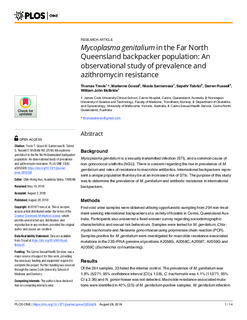| dc.contributor.author | Trevis, Thomas | |
| dc.contributor.author | Gosse, Marianne | |
| dc.contributor.author | Santarossa, Nicola | |
| dc.contributor.author | Tabrizi, Sepehr | |
| dc.contributor.author | Russell, Darren | |
| dc.contributor.author | McBride, William John | |
| dc.date.accessioned | 2019-08-30T10:36:51Z | |
| dc.date.available | 2019-08-30T10:36:51Z | |
| dc.date.created | 2018-08-30T14:41:38Z | |
| dc.date.issued | 2018 | |
| dc.identifier.issn | 1932-6203 | |
| dc.identifier.uri | http://hdl.handle.net/11250/2611827 | |
| dc.description.abstract | Background
Mycoplasma genitalium is a sexually transmitted infection (STI), and a common cause of non-gonococcal urethritis (NGU). There is concern regarding the rise in prevalence of M. genitaliumand rates of resistance to macrolide antibiotics. International backpackers represent a unique population that may be at an increased risk of STIs. The purpose of this study was to determine the prevalence of M. genitalium and antibiotic resistance in international backpackers.
Methods
First void urine samples were obtained utilising opportunistic sampling from 294 non-treatment-seeking international backpackers at a variety of hostels in Cairns, Queensland Australia. Participants also answered a fixed-answer survey regarding sociodemographic characteristics and sexual risk behaviours. Samples were tested for M. genitalium, Chlamydia trachomatis and Neisseria gonorrhoeae using polymerase chain reaction (PCR). Samples positive for M. genitalium were investigated for macrolide resistance-associated mutations in the 23S rRNA genome at positions A2058G, A2058C, A2058T, A2059G and A2059C (Escherichia colinumbering).
Results
Of the 294 samples, 23 failed the internal control. The prevalence of M. genitalium was 1.8% (5/271, 95% confidence interval [CI] ± 1.58), C. trachomatis was 4.1% (11/271, 95% CI ± 2.36) and N. gonorrhoeae was not detected. Macrolide resistance-associated mutations were identified in 40% (2/5) of M. genitalium-positive samples. M. genitalium infection was associated with reporting symptoms (odds ratio [OR] 14.36, 95% CI 2.17–94.94, p < 0.05).
Conclusions
M. genitalium and C. trachomatis are relatively common amongst non-treatment seeking international backpackers, but may not differ from Australian population prevalence. This article provides evidence to further support the increased utilisation of M. genitalium PCR in the diagnosis of NGU, and for macrolide resistance testing for all identified M. genitalium infections. | nb_NO |
| dc.language.iso | eng | nb_NO |
| dc.publisher | Public Library of Science | nb_NO |
| dc.rights | Navngivelse 4.0 Internasjonal | * |
| dc.rights.uri | http://creativecommons.org/licenses/by/4.0/deed.no | * |
| dc.title | Mycoplasma genitalium in the Far North Queensland backpacker population: An observational study of prevalence and azithromycin resistance | nb_NO |
| dc.type | Journal article | nb_NO |
| dc.type | Peer reviewed | nb_NO |
| dc.description.version | publishedVersion | nb_NO |
| dc.source.volume | 13 | nb_NO |
| dc.source.journal | PLoS ONE | nb_NO |
| dc.source.issue | 8 | nb_NO |
| dc.identifier.doi | 10.1371/journal.pone.0202428 | |
| dc.identifier.cristin | 1605590 | |
| dc.description.localcode | © 2018 Trevis et al. This is an open access article distributed under the terms of the Creative Commons Attribution License, which permits unrestricted use, distribution, and reproduction in any medium, provided the original author and source are credited. | nb_NO |
| cristin.unitcode | 194,65,1,0 | |
| cristin.unitname | MH fakultetsadministrasjon | |
| cristin.ispublished | true | |
| cristin.fulltext | original | |
| cristin.qualitycode | 1 | |

